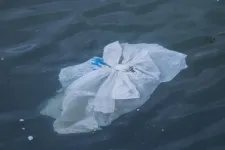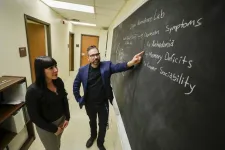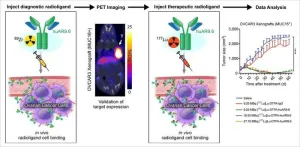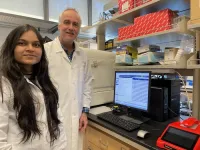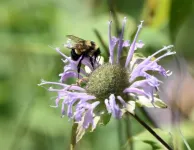(Press-News.org) New research from CSIRO, Australia’s national science agency, and the University of Toronto in Canada, estimates up to 11 million tonnes of plastic pollution is sitting on the ocean floor.
Every minute, a garbage truck’s worth of plastic enters the ocean. With plastic use expected to double by 2040, understanding how and where it travels is crucial to protecting marine ecosystems and wildlife.
Dr Denise Hardesty, Senior Research Scientist with CSIRO, said this is the first estimate of how much plastic waste ends up on the ocean floor, where it accumulates before being broken down into smaller pieces and mixed into ocean sediment.
“We know that millions of tonnes of plastic waste enter our oceans every year but what we didn’t know is how much of this pollution ends up on our ocean floor,” Dr Hardesty said.
“We discovered that the ocean floor has become a resting place, or reservoir, for most plastic pollution, with between 3 to 11 million tonnes of plastic estimated to be sinking to the ocean floor.
“While there has been a previous estimate of microplastics on the seafloor, this research looks at larger items, from nets and cups to plastic bags and everything in between.”
Ms Alice Zhu, a PhD Candidate from the University of Toronto who led the study, said the estimate of plastic pollution on the ocean floor could be up to 100 times more than the amount of plastic floating on the ocean’s surface based on recent estimates.
“The ocean surface is a temporary resting place of plastic so it is expected that if we can stop plastic entering our oceans, the amount would be reduced," Ms Zhu said.
"However, our research found that plastic will continue to end up in the deep ocean, which becomes a permanent resting place or sink for marine plastic pollution,”
Scientific data was used to build two predictive models to estimate the amount and distribution of plastic on the ocean floor - one based on data from remote operated vehicles (ROVs) and the other from bottom trawls.
Using ROV data, 3 to 11 million metric tonnes of plastic pollution is estimated to reside on the ocean floor.
The ROV results also reveal that plastic mass clusters around continents - approximately half (46 per cent) of the predicted plastic mass on the global ocean floor resides above 200 m depth. The ocean depths, from 200 m to as deep as 11,000 m contains the remainder of predicted plastic mass (54 per cent).
Although inland and coastal seas cover much less surface area than oceans (11 per cent vs 56 per cent out of the entire Earth’s area), these areas are predicted to hold as much plastic mass as does the rest of the ocean floor.
“These findings help to fill a longstanding knowledge gap on the behaviour of plastic in the marine environment,” Ms Zhu said.
“Understanding the driving forces behind the transport and accumulation of plastic in the deep ocean will help to inform source reduction and environmental remediation efforts, thereby reducing the risks that plastic pollution may pose to marine life.”
The article, Plastics in the deep sea – A global estimate of the ocean floor reservoir, was published in Deep Sea Research Part I: Oceanographic Research Papers.
This research is part of CSIRO’s Ending Plastic Waste Mission, which aims to change the way we make, use, recycle and dispose of plastic.
END
Ocean floor a 'reservoir' of plastic pollution, world-first study finds
2024-04-05
ELSE PRESS RELEASES FROM THIS DATE:
Scientists discover potential treatment approaches for polycystic kidney disease
2024-04-04
Researchers have shown that dangerous cysts, which form over time in polycystic kidney disease (PKD), can be prevented by a single normal copy of a defective gene. This means the potential exists that scientists could one day tailor a gene therapy to treat the disease. They also discovered that a type of drug, known as a glycoside, can sidestep the effects of the defective gene in PKD. The discoveries could set the stage for new therapeutic approaches to treating PKD, which affects millions worldwide. The study, partially funded by the National Institutes of Health (NIH), is published in Cell Stem Cell.
Scientists ...
UTEP study: prairie voles display signs of human-like depression
2024-04-04
EL PASO, Texas (April 4, 2024) – Psychology researchers at The University of Texas at El Paso are making progress towards understanding the biological underpinnings of depression, a leading cause of disability that affects approximately 280 million people around the world.
In a study published this April in the Journal of Affective Disorders, UTEP psychologist Sergio Iñiguez, Ph.D., and his co-authors make the case that prairie voles, small rodents that are found throughout the central United States and Canada, can be effectively used as animal models to further the study of ...
Researchers envision sci-fi worlds involving changes to atmospheric water cycle
2024-04-04
Human activity is changing the way water flows between the Earth and atmosphere in complex ways and with likely long-lasting consequences that are hard to picture.
Land use change is altering where clouds form and how precipitation is distributed. Meanwhile, weather modification activities like cloud seeding are shifting how nations plan for water use in the face of climate change. These and other changes to the planet’s atmospheric water cycle were once hard to imagine but are increasingly part of modern water management on the planet.
Colorado State University Assistant Professor Patrick Keys is an expert ...
Novel theranostic tool allows for noninvasive identification and treatment of ovarian cancer
2024-04-04
Reston, VA—A new radiotheranostic system has the ability to detect and treat ovarian cancer noninvasively, according to new research published in the April issue of The Journal of Nuclear Medicine. Combining the highly specific huAR9.6 antibody with PET and therapeutic radionuclides, this theranostic platform may provide more personalized treatment to improve health outcomes for ovarian cancer patients.
Ovarian cancer causes more deaths than any other gynecologic malignancy, with a five-year survival rate below 30 percent for patients diagnosed at advanced stages. The current standard of care for ovarian cancer consists of surgery followed by platinum-based chemotherapy; however, ...
An NSF bootcamp for future scientists
2024-04-04
Research today doesn't only occur in a lab; indeed, many university researchers extend their work into the community with the goal of inspiring the next generation of scientists and engineers. And some government agencies, like the National Science Foundation, provide the funding to do so. Most recently, Xiayun Zhao, assistant professor of mechanical engineering & materials science at the University of Pittsburgh, completed such outreach at the Carnegie Science Center (CSC).
Zhao ...
Small protein plays big role in chronic HIV infection
2024-04-04
RIVERSIDE, Calif. -- NeuroHIV refers to the effects of HIV infection on the brain or central nervous system and, to some extent, the spinal cord and peripheral nervous system. A collection of diseases, including neuropathy and dementia, neuroHIV can cause problems with memory and thinking and compromise our ability to live a normal life.
Using a mouse model of neuroHIV, a research team led by biomedical scientists at the University of California, Riverside, studied the effects of interferon-β (IFNβ), a small protein involved in cell signaling and integral to the body’s natural defense mechanism against viral infections. The researchers found that higher or lower than ...
Perinatal women of Mexican descent propose solutions to pandemic-related stressors affecting Latinos
2024-04-04
CHAMPAIGN, Ill. — Public policies blocked many families of Mexican descent living in the U.S. from accessing vital services such as food and mental health care during the COVID-19 pandemic, even though these communities experienced some of the highest infection and mortality rates.
Thirty-eight perinatal women and mothers of young children were interviewed about the challenges they faced during the pandemic and proposed solutions to better meet the needs of their communities during future large-scale crises in a study led by University of Illinois Urbana-Champaign kinesiology and community health ...
Novel biological mechanism discovered that could lead to new treatments for neurological disorders, cancers
2024-04-04
The lab of Yongchao C. Ma, PhD, at Stanley Manne Children’s Research Institute at Ann & Robert H. Lurie Children’s Hospital of Chicago discovered a fundamental biological mechanism that could lead to new treatments for neurological diseases, such as spinal muscular atrophy (SMA) and autism, as well as different cancers. The study was published in the journal Human Molecular Genetics.
Dr. Ma’s team found that chemical modification of RNA (called RNA methylation) regulates mitochondrial ...
Stellar collisions produce strange, zombie-like survivors
2024-04-04
Despite their ancient ages, some stars orbiting the Milky Way’s central supermassive black hole appear deceptively youthful. But unlike humans, who might appear rejuvenated from a fresh round of collagen injections, these stars look young for a much darker reason.
They ate their neighbors.
This is just one of the more peculiar findings from new Northwestern University research. Using a new model, astrophysicists traced the violent journeys of 1,000 simulated stars orbiting our galaxy’s central supermassive black hole, Sagittarius A* (Sgr A*).
So densely packed with stars, the region commonly experiences brutal stellar collisions. ...
Rusty-patched bumblebee’s struggle for survival found in its genes
2024-04-04
A team of researchers has uncovered alarming trends in the first range-wide genetic study of an endangered bee species. The study, led by Colorado State University and published in the Journal of Insect Science, will inform conservation and recovery efforts for the rusty-patched bumblebee – a species that was once common in the United States but has declined from about 90% of its historic range.
The rusty-patched bumblebee was the first bee species to be federally listed as endangered in 2017 through the U.S. Endangered Species Act. Its numbers dropped rapidly starting in the late 1990s, likely due to a combination of pesticides, ...
